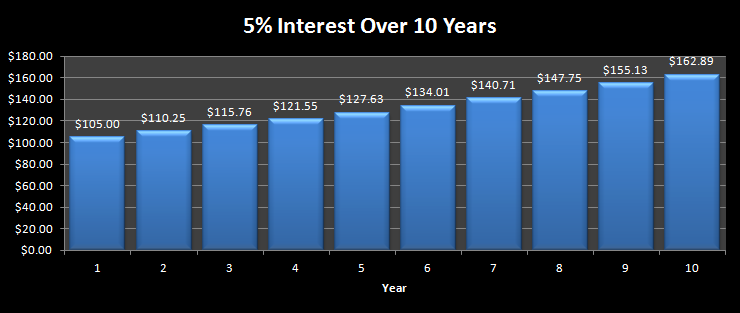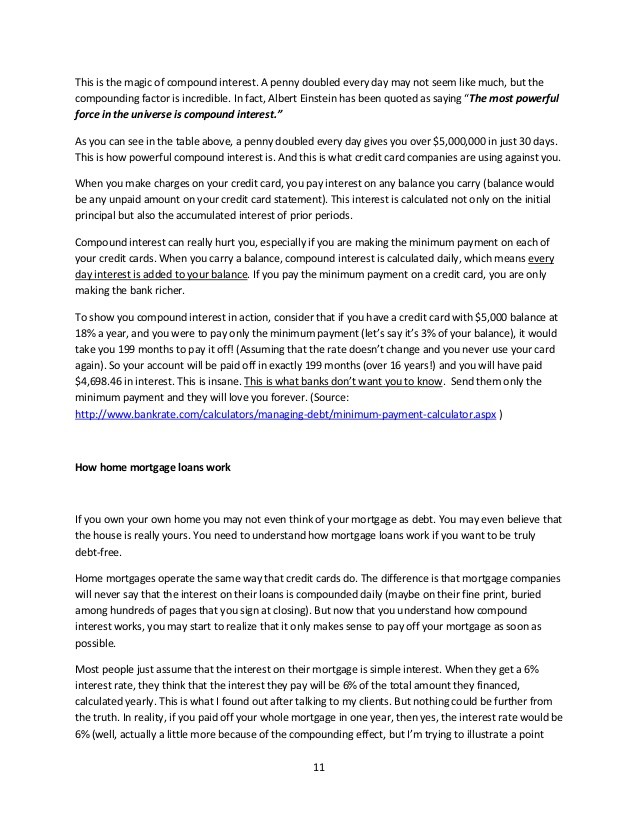Compound Interest 101 How It Works
Post on: 3 Июнь, 2015 No Comment

Posted on Aug 16, 2012
Heres another interesting post from our friends at InvestingAnswers :
Albert Einstein called it the greatest mathematical discovery of all time.
For those regularly carrying hefty debt on their monthly credit card bill, Einsteins law of financial physics is not good news. But for the savvy investor, the principles of compound interest can be used to make a substantial amount of money over time.
To tap into the money-making magic of compound interest, its crucial to first understand what compound interest is and how it works.
Financially speaking, compounding is the exponential increase of an investment. But in simpler terms, compounding is interest you earn on interest.
For example, lets say you put $2,000 in the bank. If interest is paid 5% annually, the bank will give you about $100 in interest for the first year of your investment. If you leave that $100 in your account, it will start earning interest, too. The following year, your $2,100 principal balance will earn $105 in interest. Over time, this phenomenon turns into the powerful magic of compound interest.
Here are some important ways to make compound interest work to your advantage:
Use the power of time
Compound interest is most powerful over a long period of time. Looking at the above example, your $2,000 initial investment would double in about 14 years. If all the money remained untouched, it would earn twice as much interest between years 15 through 28. In year 29, youd effectively be earning 20% interest on the original investment (sometimes called yield on cost ), all without needing to lift a finger.
See for yourself:
The earlier you start, the better
Whether youre in your mid-30s or mid-60s, its never too late to start saving. If you can afford to put away even $100 a month, starting now, compound interest will duly reward you even in todays low interest rate environment.
For example, at age 33, a $100-per-month ($1,200 annual) contribution at a 1.5% annual interest rate will turn into nearly $60,000 by age 70. If you start at age 66, this same investment amounts to just $5,000. Still, not bad. But, it clearly demonstrates that the longer you can let your investment sit and earn interest, the better.
Maximize your compounding periods:
The more frequently interest is paid, the more quickly wealth will build. Interest that compounds monthly will grow faster than interest that compounds quarterly or yearly. Therefore, to more quickly obtain wealth, always chose the shortest compounding period you can.
Earn interest, dont pay it:
Compound interest can work the other way, too. A typical credit card company charges 20% monthly interest on unpaid balances. Factoring in 20% compound interest, an unpaid credit card balance of $1,000 at the beginning of the year will turn into over $1,200 in debt by the end of the year. To reduce your debt load. inversely apply the principles of compound interest. If you can, transfer your credit card debt to a lower interest plan. And, if you can, chose loans with a yearly, rather than monthly or quarterly, interest payment.
Taking these principles into account, there are many investment vehicles built to compound. All can help maximize your wealth-building efforts.
Here are some top contenders to consider:
1. High-Interest Savings Accounts
In this low-interest environment, its hard to find banks offering attractive rates. However, with enough digging, some decent rates can be found. Currently, 1.08% seems to be the top interest rate in the U.S. while 2.1% is the best rate weve found in Canada.
If youre looking to invest now, you may want to pay particular attention to websites that update bank interest rate information on a daily basis. Even a few percentage points can make a difference. For example, a $5,000 investment that earns 0.8% compound interest over 5 years can turn into $5,200. This same investment at a 2% compound interest rate will turn into about $5,500. For the extra $300, its probably worth the 30 minutes it may take to find the better rate. Bankaholic is particularly good for U.S. consumers, while High Interest Savings is a good one for Canadians.
Its also nice to know that, although banks may list going rates on their websites, many are willing to negotiate. Before agreeing to a set rate whether it be for a high interest savings account. a loan or even a car payment ask if the provider has any discretion. You may get a somewhat baffled look, but, by just asking, the lender is likely to give you the most advantageous rate available.
2. Certificates of Deposit (CDs)/Guaranteed Investment Certificates (GICs)

These are secure investment vehicles (CDs in the U.S. GICs in Canada) that offer a fixed interest rate until a specific maturity date. The advantage of this investment tool over a high-interest savings account is it offers a guaranteed interest rate that will remain unchanged for the term of your investment. The catch is your money is not liquid. You must keep it locked up for the specified time period. Early withdrawal often results in a penalty. The interest gain is generally taxable.
There are different types of CDs and GICs. Each have their own terms, advantages and disadvantages. Currently, CD and GIC interest rates are about on par with high-interest savings account rates. As such, for the average investor, it is currently likely no more advantageous than a more liquid high-interest savings account.
3. Stock Dividend Payments
Stocks that pay dividends can be a great way to bring in extra income. To realize the power of investing dividend payments, check out the story of Grace Groner:
After graduating from Lake Forest College in 1931, Grace was hired as a secretary at Abbott Laboratories. where she worked for more than four decades.
Grace never earned an amazing salary as a secretary. According to the Los Angeles Times, she got her clothes from garage sales. She lived in a one-bedroom house that was willed to her when a friend passed.
But in 1935, a few years after she started her job at Abbott Labs, she bought three shares of the companys stock for about $60 per share. Her total investment was under $200.
Grace never sold those shares. Through dividends, share splits, and dividend reinvestment, when she died in 2010, her three-share purchase was worth $7 million. She left it all to her alma mater.
The two most important lessons from this story?
A) She started with $200.
B) She took advantage of the power of compounding for 75 years!
The Investing Answer
By understanding how to maximize the power of compound interest, you too can build substantial wealth over time. The important thing to remember is, no matter what shape your finances are in right now, you can change your financial future by taking advantage of compounding.














